If you’re on a quest for the ultimate rock sound, you’ve probably wondered about the best electric guitar amp settings for rock. Well, wonder no more! Today, we’re diving deep into this electrifying topic to help you find that perfect, face-melting tone. So, buckle up, and let’s get this show on the road!
You can use the table of contents below to take you to the area that interests you. Click on the little box to open it, and then click on the section of the article you want to read, or you can read from start to finish if you want the full Rock amp settings experience!
If you want to go directly to the amp settings, click here.
The Short Answer
To get the perfect electric guitar amp settings for rock, start by understanding the effects of gain, bass, mid, and treble. Different rock genres require specific amp setups; classic rock might lean towards moderate gain and a balanced EQ, while modern rock could demand higher gain and a scooped mid. Don’t forget the role of effects pedals and guitar pickups in shaping your tone. Experiment and adjust everything based on your musical needs.
Keep On Reading (Below) To Learn More
What Is A Rock Tone?
When we talk about a “rock tone,” we’re referring to that gritty, overdriven sound that’s been the backbone of rock music for decades. It’s the sound that makes your guitar sing, scream, and everything in between.
But achieving that perfect rock tone isn’t just about cranking up the volume; it’s an art form that involves a deep understanding of your amp settings.
Why Amp Settings Matter
You see, your amp is more than just a big box that makes your guitar louder. It’s the secret sauce that can either make your guitar sound like a divine instrument or a complete disaster.
The right amp settings can bring out the nuances in your playing, making each note resonate with emotion. On the flip side, the wrong settings can make even the best guitar sound like a tin can.
The Role Of The Amplifier
The amplifier isn’t just a glorified speaker; it’s your guitar’s best friend. Think of it as the Robin to your guitar’s Batman. When you strum those strings, the electric signals from your guitar need amplification to be heard loud and clear.
But it’s not just about volume. The amplifier shapes these signals, adding color, texture, and, yes, that much-coveted distortion. In essence, the amplifier works in tandem with your electric guitar to produce the rock tone you’re after.
The Importance Of Tone
Now, let’s talk about tone. No, not the dial tone on your phone, but the sonic signature of your guitar. In rock music, your tone is your identity. It’s what sets you apart from every other guitarist on the block.
A good tone complements the music and enhances the emotional impact of each note. It’s the difference between a guitar that sounds like it’s weeping and one that sounds like it’s wailing. In rock, achieving the right tone is not just important; it’s crucial.
The Core Elements Of Amp Settings For Rock
Understanding the core elements of amp settings is like knowing the ingredients of a secret sauce. Each knob and switch plays a role in shaping your sound, and knowing how to manipulate them can make or break your rock tone.
Gain
All Rock players love gain, the magic knob that adds that delicious distortion to your sound! But be warned, too much gain, and you’ll end up in Metal territory. Too little, and your rock tone will lack that essential bite.
The sweet spot? Somewhere between 4 and 7, depending on your guitar and the style of rock you’re playing. Higher output pickups, like humbuckers, will typically require less gain.
Equalization (EQ): Bass, Mid, And Treble
These are the core frequency ranges that you’ll be tweaking to shape your rock tone.
Bass provides the foundational low-end that gives your sound its depth and weight. It’s the backbone of your tone, especially when you’re laying down those heavy riffs.
Midrange is where the personality of your guitar really shines through. It’s the frequency range that brings out the nuances in your solos and makes your chords rich and full.
Treble, on the other hand, offers the high-end sparkle and brightness. It ensures that your guitar stands out, adding clarity to each note you play.
Balancing these three frequency ranges is essential for achieving that perfect rock tone.
Volume
Volume is an often misunderstood setting. It’s not just about being loud; it’s about achieving a balanced sound that fills the room without overpowering it.
Too low, and you’ll get lost in the mix.
Too high, and you risk drowning out the rest of the band.
The key is to find a volume setting that complements the rest of your settings and the acoustics of the room you’re playing in.
Presence And Contour Knobs
While Gain, Bass, Mid, and Treble are the mainstays of amp settings, the Presence and Contour knobs are like the secret spices in a gourmet dish. They offer that extra layer of tonal control that can elevate your rock sound from good to great.
These control settings are typically found on higher-end boutique amps.
Presence
The Presence knob controls the upper-mid to high frequencies, usually around 4kHz to 6kHz. It adds a certain “airiness” and “sparkle” to your tone, making it more lively and vibrant.
When you increase the Presence, your guitar sound becomes more cutting and articulate, which is especially useful for solos or when you want to stand out in a mix. However, too much Presence can make your tone harsh, so it’s all about finding that sweet spot.
Contour
The Contour knob is essentially a midrange control but with a twist. Instead of boosting or cutting a fixed midrange frequency, it sweeps through the midrange, allowing you to select which mid frequencies to emphasize or de-emphasize.
Turning the Contour knob clockwise will scoop out the mids, giving you a more modern, aggressive tone. Turning it counterclockwise will boost the mids, resulting in a more vintage, warm sound. It’s an incredibly versatile control that lets you fine-tune your tone to suit different styles of rock.
Reverb
Reverb is like the finishing touch, the cherry on top of your rock-tone sundae. It adds a sense of space and depth to your sound, making it feel more expansive and alive.
Essentially, reverb simulates the natural reflections of sound in a room or hall. On an amp, the Reverb knob allows you to control the level of this effect.
Types of Reverb
Classic amps typically have a single reverb knob. The higher the setting the more reverb you get.
Most modern amps come with different types of reverb settings, such as ‘Spring,’ ‘Hall,’ and ‘Plate.’ Each has its own unique characteristics:
- Spring Reverb: This is the classic reverb sound that many associate with vintage rock. It has a bouncy, shimmering quality that adds a retro vibe to your tone.
- Hall Reverb: This setting emulates the natural reverb of a large hall or auditorium. It’s more spacious and is excellent for adding depth without overwhelming your core tone.
- Plate Reverb: This type simulates the sound of a metal plate vibrating to create reverb. It’s a smoother, more even reverb that works well for a modern rock sound.
Using Reverb in Rock
In rock music, less is often more when it comes to reverb. Too much can muddy your tone, while too little can make it sound dry and lifeless.
A moderate amount of reverb can make your solos sing, and your riffs resonate without drowning them in a wash of sound. It’s all about finding that balance where the reverb complements your tone rather than overpowering it.
So, the next time you’re dialing in your electric guitar amp settings for rock, don’t overlook the Reverb knob. It’s a small adjustment that can make a big difference!
The Ideal Electric Guitar Amp Settings For Rock

Here are some suggested amplifier settings I recommend as a starting point for three types of Rock. Keep in mind that it depends on your playing style, guitar, and amplifier model.
Feel free to dial in the sound that works for you!
You can add dirt pedals, like overdrive and distortion, to really kick things up to the next level!
The Classic Rock Setup
Classic rock is a genre that takes us back to the golden era of guitar heroes like Jimi Hendrix, Jimmy Page, Eric Clapton, and Jeff Beck. To nail that vintage vibe, consider starting with the following settings:
- Gain: Set it between 5 and 6. This gives you enough crunch without turning your tone into a muddy mess.
- Bass: Keep it around 6 to add some warmth.
- Mid: Crank it up to 7 or 8. The midrange is where the guitar lives in classic rock.
- Treble: Set it at 6 for that bright, cutting-edge.
The Modern Rock Setup
Modern rock is a bit more polished and often incorporates elements of other genres. Think Foo Fighters or Queens of the Stone Age. For a modern rock tone, consider using these settings:
- Gain: Dial it back to 4 or 5 for a cleaner distortion.
- Bass: Set it at 5 for a balanced low-end.
- Mid: Lower it to 4 or 5. Modern rock often scoops the mids for a different texture.
- Treble: Crank it up to 7 or 8 for added clarity.
The Bluesy Rock Setup
If your rock leans more towards the blues side—think Stevie Ray Vaughan or Gary Clark Jr.—you’ll want a setup that allows for dynamic play. Here’s one way to dial it in:
- Gain: Set it low, around 3 or 4, for a cleaner tone that responds to your picking dynamics.
- Bass: Keep it moderate at 5 to maintain a balanced sound.
- Mid: Set it high, around 7, to emphasize the emotive quality of the blues.
- Treble: Dial it back to 5 or 6 to avoid harshness.
Rock Settings Summary Table
| Setting | Classic Rock | Modern Rock | Bluesy Rock |
|---|---|---|---|
| Gain | 5-6 | 4-5 | 3-4 |
| Bass | 6 | 5 | 5 |
| Mid | 7-8 | 4-5 | 7 |
| Treble | 6 | 7-8 | 5-6 |
Amp Settings For Iconic Rock Songs
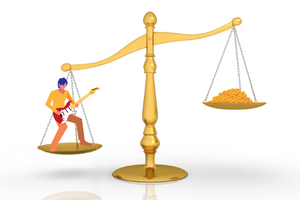
Here are some of the songs that have defined rock ‘n’ roll! Each of these iconic tracks has its own unique sound, and believe it or not, you can get pretty close to those tones with the right amp settings. Let’s dive into the specifics.
The Equipment I Used To Create These Sounds
I used the following equipment to create the sounds for the ten songs listed below. The amplifier settings are based on those particular models, but they should get you close using the amp you have.
If your amp does not have a Gain (Master Volume) setting, you’ll probably need an overdrive or distortion pedal, especially if your guitar has single-coil pickups.
Guitars
2022 Fender Player Stratocaster
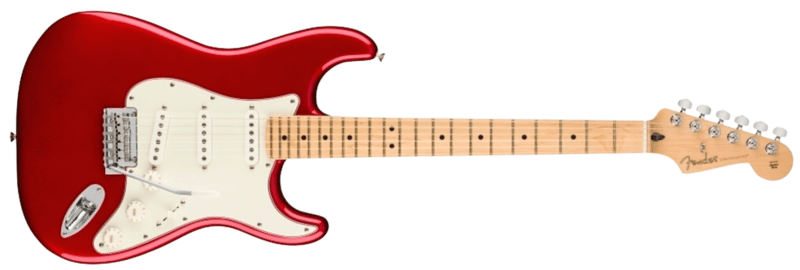
1960s Les Paul Standard Reissue
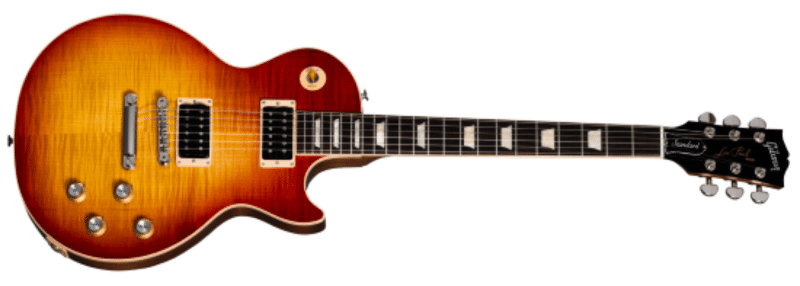
Effects Pedals
Ibanez TS808 Overdrive Pedal Reissue
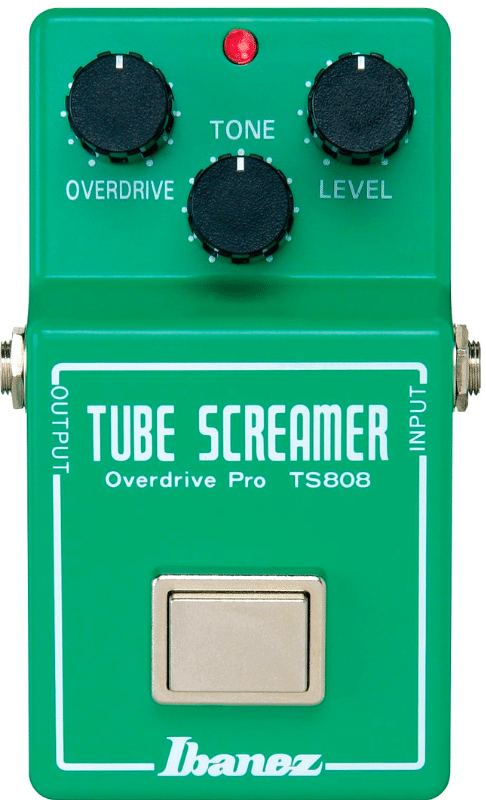
Electro-Harmonix Big Muff Pi Reissue (Distortion)

Amplifiers
1970s Fender Quad Reverb

Marshall JCM800 2203 Reissue

“Stairway to Heaven” – Led Zeppelin
Jimmy Page’s ethereal tone in “Stairway to Heaven” is legendary. A humbucker pickup will give you that warm, full-bodied sound.
Believe it or not, the iconic solo in “Stairway to Heaven” on Led Zeppelin’s fourth album was recorded by Jimmy Page using a Supro Thunderbolt amp and a 1959 Fender Telecaster.
In addition, he used a Harmony Sovereign acoustic guitar for the early parts of the song and a Fender XII 12 string for the middle section.
I used: Marshall JCM800 2203 Reissue, 1960s Les Paul Standard Reissue, Ibanez TS808 Overdrive Pedal Reissue
My amp settings:
- Gain: 5
- Bass: 4
- Mid: 6
- Treble: 7
Good for acoustic and electric parts.
“Sweet Child O’ Mine” – Guns N’ Roses
Slash’s iconic intro requires a humbucker pickup for that thick, rich tone.
Slash wielded a Gibson Les Paul through a Marshall JCM 800. He also used a Cry Baby Wah pedal for those expressive leads.
I used: Marshall JCM800 2203 Reissue, 1960s Les Paul Standard Reissue, Ibanez TS808 Overdrive Pedal Reissue
My amp settings:
- Gain: 7
- Bass: 5
- Mid: 6
- Treble: 7
Crank up the gain and treble for that signature sound.
“Back in Black” – AC/DC
For that classic Angus Young tone, a humbucker pickup is essential!
Angus rocks a Gibson SG and plugged it into a Marshall amp. He uses a lot less distortion than most players think and no typical effects pedals of any type. The secret sauce? A Schaffer-Vega wireless system that doubles as a boost!
I used: Marshall JCM800 2203 Reissue, 1960s Les Paul Standard Reissue, Ibanez TS808 Overdrive Pedal Reissue
My amp settings:
- Gain: 6
- Bass: 5
- Mid: 7
- Treble: 6
Keep the gain up and the treble moderate.
“Hotel California” – Eagles
The Eagles’ “Hotel California” features a clean, crisp tone best achieved with a mix of single-coil and humbucker pickups.
Joe Walsh used a 1977 Fender Telecaster with a ’59 Fender Narrow Panel Tweed Deluxe amp and a Fender Tweed Champ amp for the guitar solo.
Don Felder used a ’59 Gibson Les Paul and a narrow-panel Tweed Deluxe amp with a Martin 12-string acoustic guitar through a Leslie rotating speaker for the intro.
I used: 1970s Fender Quad Reverb, 1960s Les Paul Standard Reissue, Ibanez TS808 Overdrive Pedal Reissue
My Amp Settings:
- Gain: 5
- Bass: 4
- Mid: 5
- Treble: 7
Keep the gain moderate and the treble high.
“Bohemian Rhapsody” – Queen
Brian May’s unique tone can be approximated with single-coil pickups. Brian’s homemade “Red Special” guitar went through a stack of vintage Vox AC30 amps.
The guitar’s bridge and middle Tri-Sonic single-coil pickups can be switched in series and out of phase.
He also used a treble booster for extra bite and a delay unit.
I used: Marshall JCM800 2203 Reissue, 2022 Fender Player Stratocaster, Electro-Harmonix Big Muff Pi Reissue (Distortion)
My amp settings:
- Gain: 5
- Bass: 5
- Mid: 6
- Treble: 6
Keep the settings balanced for this complex tune.
“Layla” – Derek and the Dominos
Eric Clapton’s “Layla” is best played with single-coil pickups.
He used a 1956 Fender Stratocaster named “Brownie” to record the tune through a Fender Champ, a Vibro-Champ, and a Princeton Reverb.
I Used: 1970s Fender Quad Reverb, 2022 Fender Player Stratocaster, Ibanez TS808 Overdrive Pedal Reissue
My amp settings:
- Gain: 6
- Bass: 5
- Mid: 7
- Treble: 6
The mid should be a bit higher to get that bluesy feel.
“Comfortably Numb” – Pink Floyd
David Gilmour’s soulful solos in “Comfortably Numb” are best replicated with single-coil pickups.
He used a combination of amps and effects to record the guitar solo for Pink Floyd’s “Comfortably Numb.” His main amp was a Hiwatt DR103.
He has played this song on his “Black Strat” and red Strat with EMG active single-coil pickups. David uses an Electro-Harmonix Big Muff with a Colorsound Power Boost.
I Used – Marshall JCM800 2203 Reissue, 2022 Fender Player Stratocaster, Electro-Harmonix Big Muff Pi Reissue (Distortion)
My amp settings:
- Gain: 5
- Bass: 4
- Mid: 6
- Treble: 7
Keep the gain moderate and mid moderate, and the treble high.
“Sultans of Swing” – Dire Straits
Mark Knopfler’s fingerstyle magic on “Sultans of Swing” shines through with single-coil pickups on a 1961 Fender Stratocaster, which he played through a 1961 Fender Vibrolux amp.
He uses the 1 & 2 position (bridge & middle) of the 5-way switch on his guitar.
Mark also uses compressor, delay, and reverb effects.
I Used: 1970s Fender Quad Reverb, 2022 Fender Player Stratocaster, Ibanez TS808 Overdrive Pedal Reissue
My amp settings:
- Gain: 3
- Bass: 4
- Mid: 6
- Treble: 6
Keep the gain on the low side with the mid and treble moderate for this one.
“Pride And Joy” – Stevie Ray Vaughan
Stevie Ray Vaughan’s tone is all about the blues, and single-coil pickups will get you there.
Stevie used his 1962/63 Fender Stratocaster, nicknamed “Number One,” as his main guitar.
He played it through a Dumble amplifier with a 4 X 12 cabinet and two Fender Vibroverbs.
I Used: 1970s Fender Quad Reverb, 2022 Fender Player Stratocaster, Ibanez TS808 Overdrive Pedal Reissue
My amp settings:
- Gain: 7
- Bass: 4
- Mid: 7
- Treble: 7
Crank up the gain, mid, and treble for that raw energy.
“American Woman” – The Guess Who
For that gritty, rebellious tone in “American Woman,” go for a humbucker pickup.
The song “American Woman” was recorded by Randy Bachman using a 1959 Les Paul guitar and two Garnet amps, one of which was used as a preamp.
Randy called this double amp setup the “Herzog.”
I Used: 1970s Fender Quad Reverb, 1960s Les Paul Standard Reissue, Ibanez TS808 Overdrive Pedal Reissue
My amp settings:
- Gain: 6
- Bass: 5
- Mid: 5
- Treble: 6
Settings: Keep the settings fairly balanced.
Summary Of Iconic Rock Songs And Their Amp Settings
| Song | Band | Gain | Bass | Mid | Treble | Pickups |
|---|---|---|---|---|---|---|
| Stairway to Heaven | Led Zeppelin | 5 | 4 | 6 | 7 | Humbucker |
| Sweet Child O’ Mine | Guns N’ Roses | 7 | 5 | 6 | 7 | Humbucker |
| Back in Black | AC/DC | 6 | 5 | 7 | 6 | Humbucker |
| Hotel California | Eagles | 5 | 4 | 5 | 7 | Humbucker |
| Bohemian Rhapsody | Queen | 5 | 5 | 6 | 6 | Single-Coil |
| Layla | Derek and the Dominos | 6 | 5 | 7 | 6 | Single-Coil |
| Comfortably Numb | Pink Floyd | 5 | 4 | 6 | 7 | Humbucker |
| Sultans of Swing | Dire Straits | 3 | 4 | 6 | 6 | Single-Coil |
| Pride and Joy | Stevie Ray Vaughan | 7 | 4 | 7 | 7 | Single-Coil |
| American Woman | The Guess Who | 6 | 5 | 5 | 6 | Humbucker |
Common Mistakes To Avoid
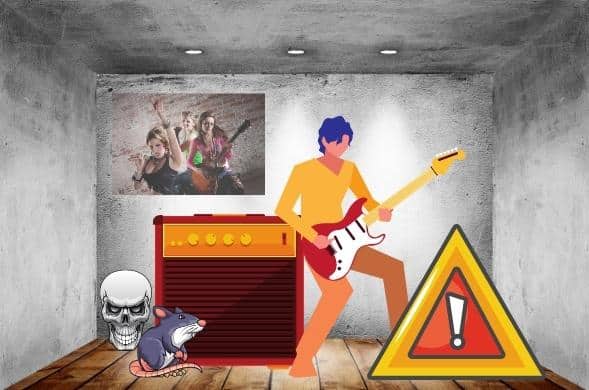
Rock ‘n’ roll may be about breaking the rules, but when it comes to amp settings, some guidelines can help you avoid sounding like a garage band on a bad day. Let’s delve into some common mistakes that can mess up your rock tone.
Avoiding these common pitfalls can make a world of difference in your quest for the ultimate rock tone. So, the next time you plug in, keep these tips in mind. Your tone—and your audience—will thank you.
Overdoing The Gain
Gain is often viewed as the essence of Rock and Roll for many beginning players. I couldn’t get enough gain when I first started playing. If it was overdriven or distorted to the max, it wasn’t happening! Lol
Cranking up the gain might seem like the quickest route to rock stardom, but too much can turn your tone into a muddy mess. The trick is to find that sweet spot where your guitar sings but doesn’t scream.
Legends like Angus Young and Slash use gain effectively but not excessively. So, next time you reach for that gain knob, show some restraint. Your audience will thank you.
Neglecting The EQ
Equalization, or EQ, is the unsung hero of a great rock tone. Many players set it once and forget it, or worse, ignore it altogether. Big mistake! Your bass, mid, and treble settings are crucial for shaping your sound.
For instance, too much bass can make your tone sound boomy, while too much treble can make it piercing. Always take the time to fine-tune your EQ settings to match your guitar, amp, and, yes, even the room you’re playing in.
Playing Too Loud
I get it; rock is meant to be loud. But there’s loud, and then there’s “my neighbors are calling the cops” loud.
Playing at excessive volumes can not only annoy everyone within a five-mile radius but also distort your tone. Most amps have a “sweet spot” where they sound the best, and it’s usually not with the volume knob cranked to 11.
Find that optimal level where your amp and guitar harmonize, and you’ll achieve a rock tone that’s powerful but not overpowering.
Pro Tips For Advanced Players
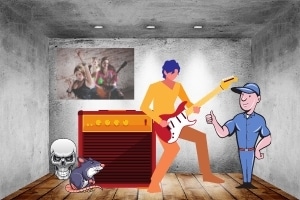
So, you’ve mastered the basics, and you’re ready to take your rock tone to the next level. Excellent! Advanced players often seek that extra edge to make their sound truly unique. Here are some pro tips that can elevate your rock tone from good to legendary.
Utilizing Effects Pedals
Effects pedals are like the spices in a great meal; a little can enhance the flavor, but too much can ruin it. Knowing how to effectively use pedals like overdrive, delay, and chorus can add depth and complexity to your sound.
For instance, a Tube Screamer can give you that extra push for solos, while a subtle delay can add dimension to your rhythm playing. The key is to use them judiciously and in the right context.
The Importance Of Pedal Order In The Signal Chain
The order of your pedals in the signal chain can make a big difference in your overall sound!
The general rule of thumb is to place pedals that affect your guitar’s tone first, followed by those that affect the volume, and finally, those that add modulation or time-based effects.
For example, a typical rock setup might go like this: tuner -> wah -> overdrive -> chorus -> delay -> reverb. Placing an overdrive pedal before a chorus pedal ensures that the chorus effect modulates the overdriven signal, not the other way around. This keeps your overdrive punchy and your chorus lush rather than muddying up your sound.
Pedal Placement: Guitar To Amp Vs. Effects Loop
Now, let’s talk about where to place these pedals: between your guitar and amp input or in an effects loop.
Generally, pedals that shape your basic tone should go between your guitar and the amp’s input. These include your tuners, wahs, overdrives, and distortions. They work best when they interact directly with your guitar’s raw signal.
Overdrive and distortion pedals are meant to “spike” the preamp section of your guitar amplifier to give your guitar saturation and sustain.
On the flip side, modulation and time-based effects like chorus, flanger, delay, and reverb usually go in the effects loop. Why? Because the effects loop bypasses the amp’s preamp stage, these pedals receive a more consistent signal, allowing them to do their job without being affected by the amp’s inherent tone or any earlier pedals in the chain.

If your guitar amplifier doesn’t have an effects loop, then it’s generally best to put the pedals that would go in an effects loop after the pedals that would go between your guitar and the amp’s input.
So, to sum it up, understanding the order of your pedals and where to place them in your setup can make a world of difference in achieving that killer rock tone. It’s all about synergy, folks. Get the sequence right, and you’ll be amazed at how good you can sound.
The Role Of The Guitar Pickups
Pickups are often the unsung heroes of your guitar setup. Whether you’re using single-coils or humbuckers can significantly impact your tone.
Single-coils are great for a bright, twangy sound; think Stevie Ray Vaughan or Mark Knopfler.
Humbuckers, on the other hand, offer a warmer, fuller sound that’s perfect for heavy rock tones like those of Slash or Jimmy Page.
But it’s not just about the pickup type; the position matters, too. The neck pickup gives a mellower tone, while the bridge pickup is sharper and more aggressive. Knowing when to switch between them during a performance can add dynamic range to your playing.
Higher output pickups, like humbuckers, can overdrive an amp more than single-coil pickups. If the output of your guitar pickups is not high enough to get the overdrive or distortion you need from your amp, consider using a dirt pedal or changing guitars.
Expert Opinions On Amp Settings For Rock

When it comes to dialing in the perfect rock tone, who better to consult than the experts? Let’s delve into the wisdom of music educators, professional guitarists, and guitar technicians to get their take on amp settings for rock.
Music Educators
Music educators often emphasize the importance of understanding your amp’s settings to achieve the desired tone.
Berklee College of Music, for instance, offers courses that cover amp settings as part of their guitar curriculum.
Professional Guitarists
Many professional guitarists have shared their insights on amp settings for rock.
Slash, the iconic guitarist of Guns N’ Roses, has often spoken about his preference for Marshall amps with moderate gain settings. In an interview with Guitar World, he mentioned, “I like to keep it simple. Just enough gain to sustain, but not too much to lose clarity.”
Similarly, Joe Bonamassa, a modern blues-rock virtuoso, has been open about his love for vintage amp settings. He often leans towards a cleaner tone, stating in interviews that “less is more” when it comes to gain.
Guitar Technicians
Guitar techs are the unsung heroes behind every great rock sound. They’re usually the ones tweaking the amp settings before a big show, ensuring the artist’s tone is spot-on.
While they may not be as vocal as the artists themselves, their expertise is invaluable.
For instance, Trace Foster, who has been the guitar tech for artists like Joe Perry and Ryan Adams, recommends a balanced EQ setting to start with and then adjusting according to the room’s acoustics.
My Personal Experience With Rock Tone Settings.

The quest for the perfect rock tone. It’s a journey I’ve been on for years, and let me tell you, it’s been a wild ride. When I first started out, I was all about getting my hands on the most expensive gear I could find. But experience has taught me that it’s not about the price tag; it’s about understanding your equipment.
I usually recommend that beginners start with an affordable amplifier that can deliver a good clean tone. For example, a Fender Twin Reverb is a solid choice for this. Pair it with a guitar that has humbucking pickups, and you’ve got yourself a setup that can really drive your amp. The humbuckers provide that extra signal output you’ll need to get those rock tones cooking, or you can back down the guitar’s volume to clean it up.
Now, don’t just plug in and play. Spend some quality time with your amp and guitar. Tweak the EQ, mess around with the gain, and don’t be afraid to crank up the volume a bit. Get to know the range of sounds you can produce. Once you’ve got a handle on that, an overdrive or distortion pedal can be your next purchase to fine-tune your rock tone.
As you continue to grow as a musician, your gear will likely grow with you. More amplifiers, guitars, and effects pedals will find their way into your collection. But remember, the key to a great rock tone isn’t just what you play; it’s how you play it!
So, whether you’re a newbie or a seasoned pro, take the time to really understand your gear. Your band and your audience will thank you for it!
Key Takeaways

Here are five essential points to remember about electric guitar amp settings for Rock.
- Affordable Gear Can Rock Too: You don’t need to break the bank to get a great rock tone. Starting with an affordable amp can set you on the right path.
- Know Your Pickups: The type of pickups you have, single-coil or humbucker, can significantly influence your tone. Choose wisely based on the songs you aim to play.
- Pedal Order Matters: The sequence in which you arrange your effects pedals can drastically affect your overall sound. For instance, placing a delay pedal before a distortion pedal will yield different results than the reverse.
- The EQ Trinity: The right Bass, Mid, and Treble settings are essential. Each serves a unique purpose in shaping your tone, and neglecting any of them can lead to a flat or muddy sound.
- Practice Makes Perfect: The more you experiment with your amp settings, the better you’ll understand what works for you. Don’t be afraid to spend time tweaking and testing to find your ideal rock tone.
Frequently Asked Questions

Here are some of the questions I get asked about amplifiers for Rock music.
If your question does not appear here, please put it in the comments, and I will get right back to you with an answer.
Why Doesn’t My Guitar Sound Crisp?
If your guitar doesn’t sound crisp, it could be due to a variety of factors, such as old strings, poor EQ settings on your amp, or even the quality of your guitar pickups. Make sure to replace old strings, fine-tune your amp settings, and consider upgrading your pickups for a crisper sound.
What Gauge Strings Are Best For Rock Music?
The choice of string gauge for rock music can vary based on personal preference and playing style. However, medium to heavy gauges like .010-.046 or .011-.048 are commonly used for a fuller tone and better sustain.
How Loud Should A Guitar Amp Be On Stage?
The volume of your guitar amp on stage will depend on the venue size, the band’s overall volume, and the sound engineer’s requirements. Generally, it’s best to start at a moderate level and adjust as needed during soundcheck to blend well with the rest of the band.
How Do I Get The Most Distortion Out Of My Amp?
To get the most distortion out of your amp, crank up the gain or “drive” setting to its maximum level. You can also boost the signal going into the amp by using an overdrive or boost pedal. However, be cautious, as excessive gain can lead to a muddy or noisy tone.
How Do You Make Distortion Clearer?
To make your distortion clearer, focus on dialing back the gain and fine-tuning your EQ settings. A common mistake is cranking up the gain too high, which can muddy your tone. Adjusting the mid and treble settings can also add clarity to your distorted sound.
What Is A Stack Amp?
A stack amp consists of a separate amplifier head and speaker cabinet. It offers more power and customization but is less portable than combo amps.
What Is A Modeling Amp?
A modeling amp digitally replicates the sounds of various other amplifiers, offering a wide range of tones in a single unit.
How Important Is The Speaker Size?
Larger speakers generally offer more bass response and volume, while smaller ones provide a more focused sound.
What Is Amp Wattage?
Amp wattage indicates the power output. Higher wattage is typically better for large venues, while lower wattage is ideal for home use.
What Is A Power Attenuator?
A power attenuator allows you to lower the amp’s volume without sacrificing tone quality, which is useful for playing at home.
Can I Use Multiple Amps?
Yes, using multiple amps can create a fuller sound, but it requires careful setup to avoid problems like phase issues.
What Is A Noise Gate?
A noise gate eliminates unwanted noise and hum when you’re not playing.
What Is An Amp’s Sweet Spot?
The sweet spot is the volume level where your amp sounds its best, often around 70% of its maximum volume.
How Do I Make My Amp Sound Crunchy?
To achieve a crunchy sound on your amp, you’ll want to dial up the Gain setting while keeping the EQ balanced. Experiment with the mid-range frequencies for added bite, and adjust the volume to taste. You may need to add a dirt pedal, such as overdrive or distortion, especially if you use a guitar with single-coil pickups.
Final Thoughts

Nailing that perfect electric guitar amp settings for rock tone is a journey that begins with understanding your amp settings. From the basics of gain, bass, mid, and treble, to the nuances of different setups for classic, modern, and bluesy rock, your amp is an integral part of your sound. Don’t underestimate the power of the right settings; they can make or break your rock performance.
Common mistakes like overdoing the gain or neglecting the EQ can be easily avoided with a bit of knowledge and practice. And for those looking to take their sound to the next level, understanding the role of effects pedals and guitar pickups can be a game-changer. The order of your pedals in the signal chain and their placement, whether between the guitar and amp or in an effects loop, can significantly impact your tone.
Expert opinions from music educators, professional guitarists, and technicians offer valuable insights into achieving that elusive rock tone. But remember, the journey is personal. My own experience has taught me the value of starting simple and gradually adding complexity as you become more comfortable and skilled.
So, whether you’re jamming to “Stairway to Heaven” or crafting your own rock masterpiece, remember that your amp settings are your sonic paintbrush, laying the foundation for your musical expression.

Here’s a fantastic video from Creative Guitar Studio that goes through some of the basics involved in the guitar and amp settings to use for various sounds, including Rock. Check it out!
Tell Me What You Think

Please leave a comment below if you enjoyed this article, have any questions about amp settings for Rock, or want to give your point of view. I will be happy to help you.
- What is your favorite guitar amplifier to use for Rock? Why?
- Do you use dirt pedals to get your rock sound, or is it all from your guitar and amp settings?
- Who’s your favorite rock player and what amp settings do you use to get that sound?
- What else is on your mind?

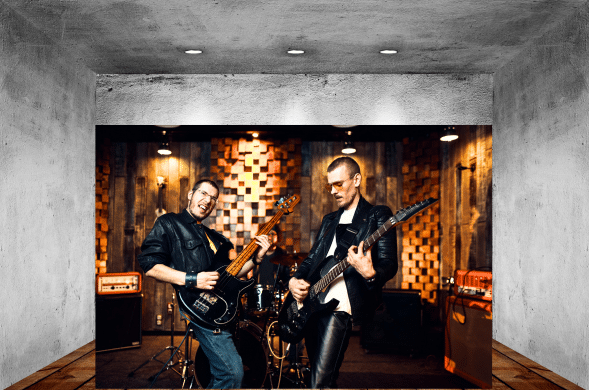

Great article on electric guitar amp settings for rock! Your insights into gain, EQ, and other elements that shape the rock tone are spot on. I appreciate the breakdown for classic rock, modern rock, and bluesy rock setups, providing a useful starting point for guitarists.
Now, here’s a question for you: In your experience, have you found that certain amp brands or models excel in producing specific rock tones, or is it more about dialing in the settings on any decent amp? I’m curious to hear your thoughts on gear choices for achieving the perfect rock sound. Keep up the fantastic work, Frank! 🎸🤘
Hi Hanna
Thank You for your comments!
The rock sound you get from an amp is really about the brand and the settings. American amps like Fender will give you that classic “tweedy, bright” sound, while amps like Marshall give that “British” sound.
Setting an amp to really push the pre-amp stage will give you more of a “Rock” sound. Some amps have a Master Volume control to assist with this, or you can use a dirt pedal like an overdrive, distortion, or fuzz box.
Rock On!
Frank
Wow, what a great resource for aspiring rock guitarists (like myself). This comprehensive guide has shed so much light on how to get better rock sounds by adjusting a few settings. The information to explain the significance of gain, EQ, and the role of effects pedals in shaping one’s sound is very helpful. Plus, it’s also cool to see your suggestions for different rock setups to make it easier to experiment, whether going for a classic, modern, or bluesy rock tone. Thanks for the work to put this information together – it’s an extremely helpful article! 🎸🤘
Hi Aly
I appreciate your comments!
I’m thrilled that you found the info in this article useful.
Please let me know if you have any questions.
Rock On!
Frank